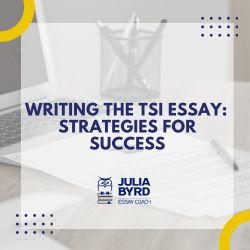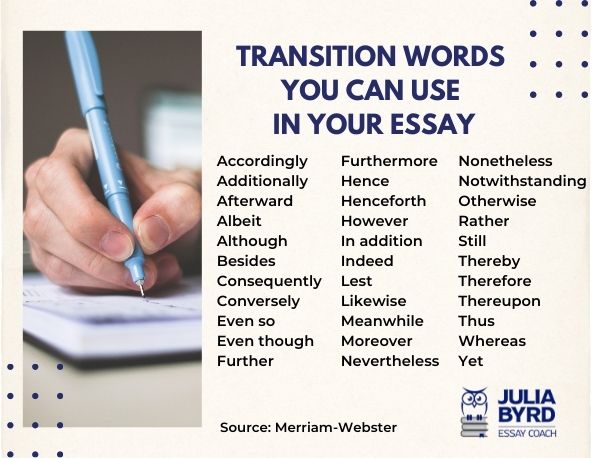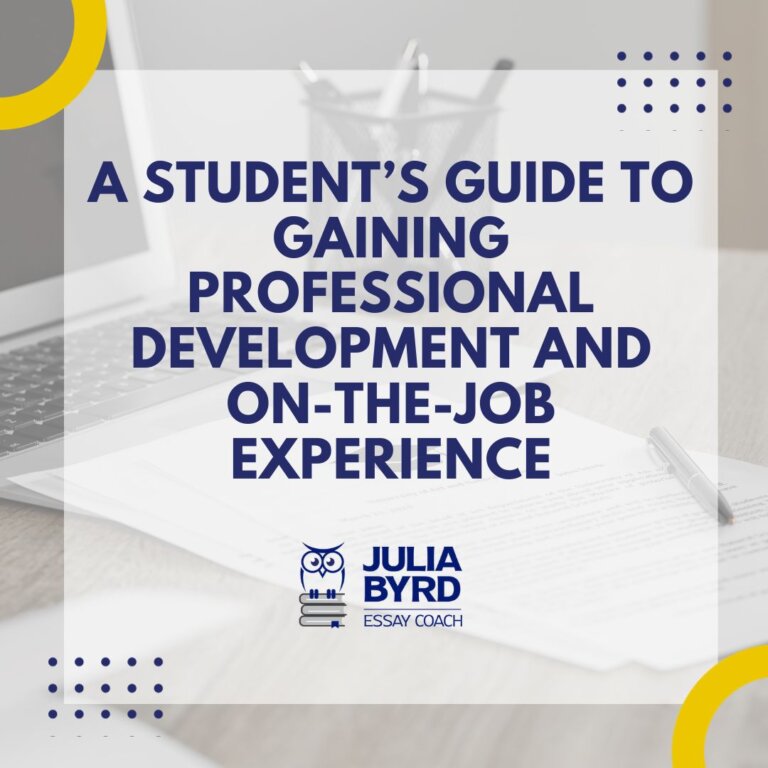Writing the TSI Essay: Strategies for Success


Writing a persuasive essay isn’t difficult, but writing an effective one does require thought and strategy. And when there’s some pressure to write that essay, like when students are writing a persuasive essay for the TSI, it can be even harder to think on the fly.
Many Texas high school students will take the Texas Success Initiative (TSI) test to evaluate their essential reading, writing, and math skills to ensure they’re prepared to succeed in freshman-level dual credit or college courses.
While writing a successful TSI essay or five-paragraph persuasive essay for English classes is much different than writing a successful personal statement, statement of purpose, or supplemental essay (the writing topics I normally cover), I thought this topic was worth discussing.
In this post, we’ll explore what the TSI persuasive essay is, how your essay is evaluated, and the strategies you can implement to achieve your desired score. I’ll also give you some links to sample TSI essays, responses, and other resources.
About the TSI Essay
For the essay portion of the TSI, you’ll receive a random essay prompt, which consists of:
- A short passage to read that’s based on an important issue
- Instructions for picking a point of view to support and then writing a persuasive essay on that point of view
You’ll need to write a roughly 500- to 600-word persuasive essay with four to five paragraphs (an opening, a closing, and three body paragraphs). The TSI is an untimed test, so you have as much time as you need. Don’t rush. Take your time and be thoughtful about your answer, even if you’d rather be anywhere than taking the test.
The TSI doesn't expect you to have any particular knowledge to answer the prompt (e.g., the prompt won’t assume you’ve read a certain book or have detailed knowledge of an event). Instead, the topic will require you to pick a side of a debatable topic/current event and then defend that side. Keep in mind that the chosen issue doesn’t have a right or wrong answer, so you won’t be judged on the position you take.
How You’ll Be Evaluated on the TSI Essay
Reviewers will evaluate your essay on these six factors, according to Mometrix Test Preparation:
- Purpose and focus. Is the information you're presenting unified, coherent, and cohesive? Do you address the issue and your position clearly? Do you keep with that position?
- Organization and structure. Are your ideas and paragraphs connected in an orderly, logical fashion? Does your organization result in a clear path from one point to another?
- Development and support. Have you developed your Ideas? Do your statements support your thesis and build upon one another, leading to a clearly developed statement or call to action? Do you give examples, explanations, and definitions? Does this supporting text help convince the reader?
- Sentence variety and style. Are your sentences and paragraphs exhibiting control of vocabulary, voice, and structure? Do you use strong action verbs and a varied word choice? Are you using active voice and writing using the same person (I)?
- Mechanical conventions. Do the ideas you express show an understanding of standard English conventions (proper grammar, spelling, punctuation, and more – all the things you were tested on in the Writing Test section of the TSI).
- Critical thinking. Does your point of view demonstrate an understanding of the relationship that exists between ideas? Are you expressing thoughts that are well-reasoned and supported? Do you clearly identify and support your point of view? Are your arguments logical enough to convince the reader of your position?
Scoring the TSI Essay: What You're Aiming for
You’ll receive a score of 1-8 on each of the six sections (although you’ll see only one overall 1-8 score), and a “college ready” score is 5 or higher. Essays that are too short to be evaluated against these criteria, that miss addressing the prompt completely, or that aren’t written in English will automatically receive a 0.
Keep in mind that a computer scores these essays, so you’re just trying to show the computer you can form a logical, well-developed argument – and use solid grammar and spelling and a decent writing style.
TSI Essay Examples
Check out these TSI essay samples from the College Board, which evaluate essays scored 1-8 and explain why these sample TSI essays received the score they did and how they could’ve been improved.
Again, you won’t be scored on your actual opinion, so don’t be concerned you’ll “lose points” if you support the less popular perspective.
Steps to Writing Your TSI Essay
Writing an effective, high-scoring essay means taking your time going through each step and really planning out your essay. While the planning portion doesn’t need to take a lot of time, but it will help you in the end by making your essay flow better and being well-thought-out.
Four important steps go into writing a great TSI essay.
1. Understand the Assignment
- Read the passage and the prompt. Read it again!
- Make sure you understand the TSI essay prompt, the issue it’s presenting, and the sides to the issue you can write about. Remember: This essay doesn’t expect you to have any technical or specific knowledge to write an effective response. Instead, you’ll use your own experiences, examples, and knowledge to defend your position.
- Consider how you’ll address the issue the passage mentions. You’ll need to pick one side of the issue to write about in your essay – even if you feel your stance on the position falls somewhere in the middle. Your score doesn't depend on which side of the issue you take; rather, it’s about how well you can support it.
2. Make a Plan
Two of the biggest factors in a high-scoring TSI essay grade are length and clarity. As a result, you’ll want to use the scratch paper you have available to decide the position you want to take and sketch out a rough outline.
On the scratch paper:
- Decide which position of the TSI essay prompt will be easiest to write about. Making this decision could involve making a two-column table and then writing down the evidence you can think of to support each position. Usually, it will become clear which one will be easier for you to write about (hint: the column with more writing/examples in it). Once you decide your position …
- List out supporting examples. Come up with four or five examples to support your position. Bring in your personal experience and knowledge to support your response to the TSI essay prompt. The more specific, the better. Names, dates, places, conversations – these specifics will help you defend your position and earn a higher score. And they can come from anywhere – history, the news, pop culture, social media, movies/TV shows, politics, sports, entertainment, family history, quotations, personal stories, etc..
- Identify the three (minimum of two) strongest examples. Those will become your body paragraphs. Finally, you'll …
- Draft your thesis statement. Based on your position and examples, what is the topic of your essay, what side of the argument will you be defending, and why have you chosen that side?
3. Start Writing
With the outlining work done, you’ve done the hard part. Congratulations. But you’re just getting started. Now it’s time to put it all together into a cohesive essay. Here’s how you’ll start writing each paragraph of your TSI essay.
Introduction
Spend no more than 3-4 sentences in your opening. Even 1-2 sentences are sufficient to state your position on the assigned topic. This will be quick and to the point, letting you spend more of your time defending your position.
In your introduction:
- Introduce the reader to the topic. This may include some sort of “hook” or attention-getting sentence that highlights the issue. This could be a quote, a personal anecdote, a historical reference, or a current piece of news.
- Admission of complexity. Acknowledge that there are many sides to the issue.
- State your thesis. Clearly and definitively state your position on the matter. This should be the last sentence of the paragraph and can include mentions of the two or three pieces of supporting evidence you’ll be presenting in the body paragraphs.
Body Paragraphs
Aim for writing three body paragraphs, but write a minimum of two. Each paragraph should have at least 4-6 sentences. Here are some other tips for writing your body paragraphs:
- Order your body paragraphs from the strongest to the weakest. Use your strongest example as your first body paragraph.
- Use transition words and phrases, like the ones below from Merriam-Webster, to signal to the reader that you're moving on to a new idea but this new paragraph is connected to the previous one.
- Follow this order in each paragraph. For an easy way to order your paragraph:
- Start with a topic sentence. Using a transition word or phrase, introduces your example and establish the point you’re going to make in this paragraph only.
- Next, fully describe that example. Be specific. Use the detailed examples you came up with in “Make a Plan” above. Use one example per paragraph. Be descriptive and thorough.
- End by explaining how this example supports your thesis. This is where you’ll spend the majority of the paragraph. Use specifics and details to convince your reader how this example demonstrates the position you hold on the topic is the right one.

Conclusion
Much like the introduction, the conclusion will be a short (3-4 sentences, max) paragraph that sums up your position, addresses the opposing viewpoint, and leaves the reader with a closing thought.
As a result, the format might look a little like this:
- Acknowledge there’s another point of view by saying that while your position is obviously the correct one, other people believe [insert a brief summary of the opposing viewpoint].
- Briefly state why that opposing position/perspective is incorrect.
- Restate why your opinion is the right one, which may include a summary of the points you’ve made in your body paragraphs.
Note: While you are mentioning the opposing viewpoint in the closing, this is not the same as taking both sides, which I cautioned against earlier. This is mentioning the other perspective but then briefly and effectively criticizing it and showing why yours is better.
Here’s a sample conclusion from TSIPracticeTest.com that shows how you can fill in the blanks:
Although ________ is demonstrably correct, some have argued that _______, believing that ________. However, this viewpoint on the present issue is negated by ________. Rather, __________. Therefore, in the long run it is clear that _____________.
4. Proofread Your Essay
Once you think you’re done writing, you’re not. Now it’s time for editing and proofreading.
Read your essay slowly, from start to finish. Make sure your ideas make sense and support your thesis. Check that you transition from one paragraph to another. You should ensure your examples are detailed, descriptive, and support your argument. Sound good? Good. But you’re not done … yet.
Because part of your score is based on spelling, grammar, and punctuation, read the essay at least once after you think it’s done. Read it back slowly to yourself, and look for any mistakes you can correct.
Remember: You have no time limit for writing the TSI essay, and taking your time now is better than having to take the test again because of errors you could’ve corrected.
Want More Help on the TSI Essay?
Hopefully these tips and tricks are enough to help you hit your targets when writing the TSI essay. But if you’re looking to read sample essays (and evaluations), practice with sample prompts, or learn more tips and tricks. You can find additional resources online, but some I found to be helpful are:
Sample TSI Essays and TSI Writing Resources
- Tips and Strategies for the TSI Essay
- College Board: WritePlacer Guide With Sample Essays
- Practice Test Essay
- TSI Essay Practice! – Michael Tooey (video, 01:20:36)
Support for the Full TSI
- TSI flash cards. These color-coded flash cards include study tips and cover mathematics, language arts, and reading. They also include practice questions.
- TSI Study Guide 2023-2024 (Jonathan Cox). This study guide includes 2 practice tests (one online, one in book), answers/explanations, access to online flash cards, and other study materials.
- TSI Study Guide 2023-2024 (Joshua Rueda). This study guide includes 3 practice tests, answers, and explanations; test-taking strategies; and a breakdown of each section.
Writing a college admission essay instead? The guidelines are much different. Learn how to get started with your personal statement.








